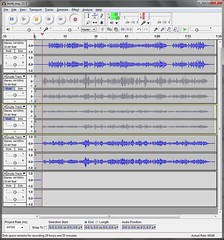Stuff going on this weekend, so pictures of the sides of my reeds comparing “manual” alignment with the Cane Guide will have to wait ‘till next week.
It’s been about a year now since I started lunch-time practicing with my fixed-up (almost) 1921 Pan-American beginner model and sent my Lorée to get revoiced in NY. I suppose my next You-Tube video should commemorate that milestone. I got the Lorée back at the end of June or beginning of July, so I still have time to get in better shape.
Update on physical progress.
No treatment this week. The weather was pretty sunny all last week, this week is turning to rain again. When the weather gets sunny, I get sore, when it gets cloudy/rainy, I get tired. But I’m doing much better than expected: yesterday the software development team spent the afternoon merging source-code all gathered around someone else’s computer. The twists and contortions I had to do to read his very small fonts should have given me a monster headache, but no, I’m doing fine! In fact, not even any Saturday morning headache. So the IMS treatments are evidently working.
(Not) Waving for the Camera
In a previous post, I discussed how swinging the body while playing might help or hinder the expressive qualities of playing. My conclusion was that too much is distracting and completely stiff is boring. I also opened the question that perhaps body motion aids in phrasing.Well, consider this video, one of my favourite pop songs of all time. I have never seen a band with fewer stage stunts … but close your eyes and just listen: there’s no denying the power and depth of their musical presence!
Can “expressiveness” be overdone?
I consider two kinds of dynamic expression: short expressions and long phrasing. The long phrasing is what we spend most of our years perfecting, the short expressions are anywhere from one to maybe 6 notes long, but describe our personal style and our understanding of how the particular style (baroque, classical, tango etc.) speaks.
I’ve been recording my practice sessions lately, and I wonder if I’m not going to far in my dynamics. The long phrasing is fine, but the short expressions will go from a true pp to a true ff in a matter of one beat. When I just write/say that, it might sound like a dream come true for the oboe, but when I record myself and play it back, I’m not so sure anymore. Then again, I need to play with the microphone and computer “gain” (sensitivity) settings and their positioning: this changes the way the recording ends-up sounding quite a lot!
When I listen to my hero Albrecht Mayer playing what could go berzerk with dynamics, I find his playing much more tame than I would expect, but full of energy and vigour nonetheless!
Computer Aided Practice Recording.
More and more, I’ve been using the computer to record my practice sessions. I’m finding it downright revealing! Using the free and powerful software Audacity, I recorded the piano accompaniment on one track. Every time I press the record button, a new track is added while playing all the tracks already there so I can hear the piano while recording. Previous tracks of my own performances can be muted one at a time or all together. This way I can compare the different performances and verify the progress.
 One REAL test for tuning is to play along with one of my previous tracks or have 2 of my tracks play together… OUCH! When playing this way, I am forced to adjust to the “other oboe”: nothing says that the “other oboe” is in tune
One REAL test for tuning is to play along with one of my previous tracks or have 2 of my tracks play together… OUCH! When playing this way, I am forced to adjust to the “other oboe”: nothing says that the “other oboe” is in tune , but there is an old saying in musical performance: “If the other guy is out of tune, it’s my fault!” [for not compensating]. This is much more difficult than playing with other instruments.
Getting the piano part is not too difficult, it requires a CD or any kind of computer file where the piano was recorded. A CD can be “ripped” with free programs such as WinLame and each tune or movement becomes a separate MP3 file. In all formats of recorded performance (actual sound file), just drag-and-drop the file onto Audacity and a new track is made for it. If you have a MIDI file, it can be converted into an actual sound file with other free software such as SUPER.


No comments:
Post a Comment